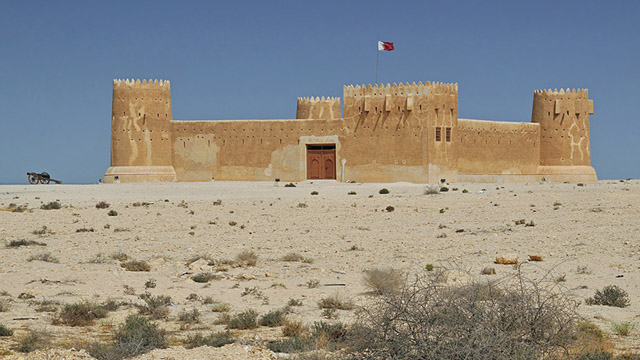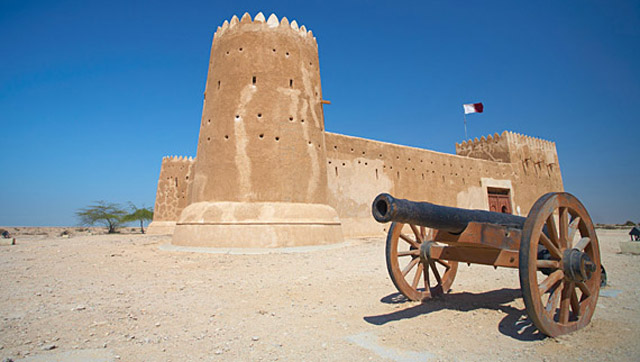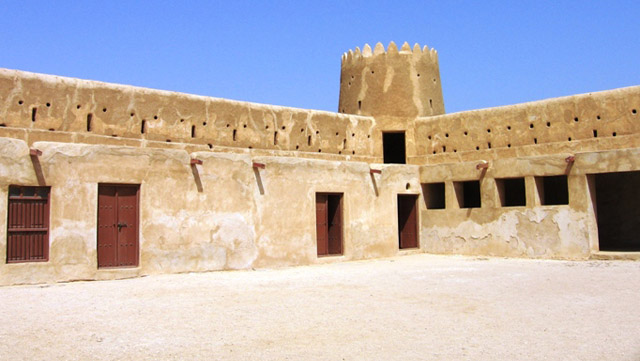Al Zubarah fort
Al Zubarah fort serves as a pristine example of a typical Arab fort built using the traditional Qatari technique.
The Coast Guard used the sturdy fort as a station until the mid 1980s when it was turned into a museum to display findings uncovered in the nearby Al Zubarah archeological area.
H.H. Sheikh Abdullah bin Qassim Al Thani built the fort in 1938 on the ruins of an older castle that had been destroyed.
It was constructed with high, thick walls that would last for countless decades and would serve to protect those inside.
The fort is a regular square courtyard with massive walls on each side. Three of the corners have large circular towers topped with Qatari-style battlements. The fourth corner contains a striking rectangular tower with traditional triangular-based ledges with slits called machicolations that - in the event of an attack - were used to shoot at enemies.
The one-meter-thick walls strengthened the defensive capabilities of the fort, and helped isolate the heat and keep the rooms cool.
The walls were built by joining overlapping raw pieces of coral rock and limestone with a mud mortar, then covering it with a gypsum-based plaster. The roof was finished with a layer of compressed mud, protecting the fort from the blazing sun during the hot seasons.
A visit to the fishermen's villages in the northwest as well as the 3D model of the Qatari mosque further show the features of this building technique. Eight rooms on the ground floor, which were originally used to accommodate soldiers, now house exhibitions of exquisite pottery and archaeological findings such as coins from the neighboring Al-Zubarah town.
The ground floor also features 'iwan' which are small porticos overlooking the courtyard through square arcades. In the courtyard, take a peek under the four-pillar canopy down the 15-meter-deep well that served as a reservoir for the soldiers.
A visit to the fort would not be complete without climbing one of the external staircases in the courtyard to the second floor. This level consists of a wide promenade and a few rooms tucked inside the corner towers. The walls of these rooms feature groups of gunfire holes that are angled in different directions so the soldiers could shoot enemies who were attacking from all sides. Wooden rung stairs that are still in the towers enabled the men to climb up to the roof and patrol the surrounding area with a clear view. This fort and the town in which it sits, are extraordinarily important pieces in the early development of Qatar, and ones that shouldn't be missed.
Planning a visit :
The Al-Zubarah fort is open daily from 8 a.m. to 6 p.m., and closed on Friday mornings. Look for Khayal, the guard at the small house next to the fort. He will be happy to let you in to explore the fort on your own.
There is no admission fee.
Consider bringing some snacks and refreshments along, as the nearest restaurant is in Madinat Al-Shamal.
Public restrooms are available at the fort.
UTM coordinates N 25° 58' 34'' E 51° 02' 43''
Address:
Al-Zubarah fort is located at the northwestern coast of Qatar, 107 km from Doha.
Take the North Road to Al-Khor for approximately 50 km and make a U-turn at the Zubarah sign.
Take the first secondary road on your right. Keep going straight until you see the fort on your right.
The road is fully paved all the way to the fort.













